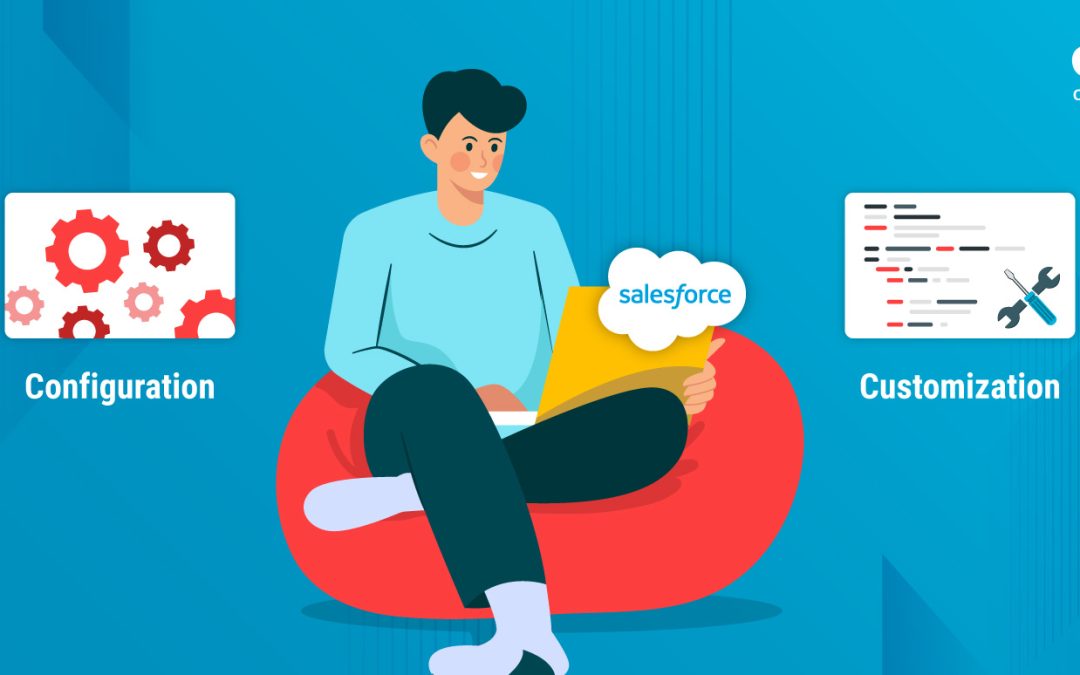Platforms, such as Salesforce, are powerful tools that offer a great deal of flexible configuration and customization. People tend to interchange configuration and customization in Salesforce quite often. Our goal is to help you with the differences between these two terms through this article so you can get the best out of your comprehensive tool. However, first, let’s clarify what Customization vs. Configuration is.
Salesforce Customization and Configuration – The Difference
The first thing we need to do is define what configuration and customization mean. Configuration is anything that can be done through Salesforce’s point-and-click interface. Adapting the platform in a declarative way allows you to configure it for many different purposes.
You are customizing whenever you need to dig into code to achieve your goals. It could mean that you have exceeded what your declarative tools can achieve, and you need to write custom code to meet your needs.
Let’s get into more details.
What is Salesforce Customization?

Advanced functionality to your CRM platform usually involves writing custom codes and algorithms. Right, it is precisely what a Salesforce customization consultant does. These elements are incorporated into a business to produce tangible results. Salesforce is usually not the only tool involved; CRM capabilities are expanded by various customizations resulting in better business processes. But how to start about it? While a Salesforce customization consultant can help you ease the process, you still need to know the “why” part before proceeding further.
How Can Salesforce Be Customized?
Here are a few examples among various possibilities for customizing Salesforce:
- Apex Classes
- Visualforce Pages/Components
- Apex Triggers
- Creating Lightning Components
- Visualforce Emails
- Integrations With 3rd Party Systems
- Using JavaScript to add capabilities & CSS to modify the look of pages
Best Practices for Salesforce Customization
- Planning the customization ahead of time will allow you to prioritize and organize all the changes inside the customized Salesforce program.
- In addition, you can use the sandbox to create customizations in Salesforce without affecting other users.
- The Salesforce experts are available to help you with some of the sophisticated automated tools for customizing Salesforce.
- Before finalizing the procedures for deployment, you will also need to test them extensively to ensure the precise process.
- Using structured conventions will help you make the interactions stronger; these must be simple but clear at the same time.
- Also, you can integrate Salesforce details with additional ones to make the customizations easier for the other developers. Additionally, you can prevent duplicates in your system.
- To make customization convenient for users, you can also provide the help text.
Salesforce Customizations that Can’t Be Missed
Customizations still depend on your business needs. However, there are a few elements that are relevant to all businesses. What are they? Read on!
User-friendly Portals
A Salesforce custom portal is a great way to improve the user experience. The client portal can easily be customized for businesses that wish to enhance communication and process efficiency to enhance productivity and growth.
A Dashboard that is Tailored to your Needs
If you want to gain a comprehensive view of all business processes, dashboards make it easy to capture business opportunities and present data more creatively. You can also customize the dashboard to increase productivity and efficiency in your team.
The Ability to Customize Views
Changing the views regularly provides a way to enhance the business’ performance. It also results in a seamless experience for end-users and helps boost the platform’s usability. Default restrictions are eliminated, and it improves convenience by offering several features, like a simple attachment upload option.
What is Salesforce Configuration?

Configuration refers to the values that permit a feature or a module to operate in Salesforce. Salesforce configuration helps to do all the modifications within the CRM system. Consequently, you can add formulas or specific rules to Salesforce to achieve a particular outcome. Even though it looks like a DIY, Salesforce consultants can help you achieve better results in less time.
How Can Salesforce Be Configured?
There are many many ways to configure Salesforce as per your business needs. Some of them are listed below:
- Email Templates
- Adding Fields and Objects
- Setting up Profiles and Permissions
- Adding Tabs and Applications
- Creating Workflows
- Validation Rules
- Reports
- AppExchange Apps
- Page Layouts
Best Practices for Salesforce Configuration
A few best practices can help you get the most from Salesforce configuration. Whether you need to deactivate inactive users or evaluate the client’s login history, here are some tips to follow.
Deactivate the Inactive Users
Ensure that users are not deactivated unnecessarily. It would help if you deactivated all inactive users after validating their reasons, like users who have left the company. Such actions will improve Salesforce’s efficiency.
Prepare Reports for Field Usage
Through this Salesforce configuration, you can identify any new sources polluting your data. To solve this issue, fields that are blank 30% of the time need to be removed. However, keep in mind that the deprecating field remains blank 95% of the time, so make sure it stays in the CRM.
Updating the Setup Audit Trail
A Salesforce configuration best practice deals with deleting or adding fields. Alterations to the fields can be made even during the last week, so make sure you record the changes you make. It would be best to document how many changes were made to the original scope.
Errors Must be Checked Regularly
Salesforce configuration should be continuously examined for any errors and risks. Diligently maintaining the logs to avoid technical glitches is crucial. Anytime an external application is synchronized with an existing system, remove the errors to prevent error patterns.
APEX Test Execution
SFDC configuration is the subject of this particular test. In this way, you can pinpoint the errors and make data cleansing a priority. Moreover, you can modify some rules as per your business needs.
Analyzing the Login History
With Salesforce’s configuration, we can examine the user lockouts and thus be more careful regarding login errors.
Salesforce Configurations that Can’t Be Missed
As stated in customization, business needs determine configuration elements. Yet relatively few configurations remain standard across the business and processes to assist them in succeeding with the approach.
Field Levels and Custom Objects
Salesforce allows you to add Custom objects and Field levels, apart from the Standard ones like Account, Contact, Lead, etc., so that you can segregate company-specific information.
Style your Interface
Your Salesforce can get monotonous with the same theme and layout. Salesforce configurations can be used to change the themes and layouts of your Salesforce interface to make it more appealing and interactive.
Rebranding Logos
A change of logo in Salesforce is another SFDC configuration you must have. Choose where you want your company logos to appear.
How to Choose the Right Approach?
Identifying your business needs is the first step in the Salesforce customization vs. Salesforce configuration debate. When in doubt if you fall into the category of configuration or customization, check the list below.
Why should you go for configuration?
- Should you need to scale to a customized solution or whether a configuration can do the job?
- Can you make the most out of the modules, built-in tools, and functionalities?
- Salesforce has many built-in features that fit your business. Did you cross-check?
Why should you go for Customization?
- If you need better performance and only a third-party integration can do the needful.
- You can get the desired information only with interactive reports and dashboards.
- The end-users have a hard time adapting to the configuration.
The idea of Salesforce customization and configuration is hopefully now clear to you. However, these are just basic checklists to start contemplating configuration vs. customization. To assess this approach, your teams must curate their choices, needs, and bottlenecks for either of the approach. Need help with anything Salesforce? Cloudiate is here to help. Contact us today or reach out for a demo.

